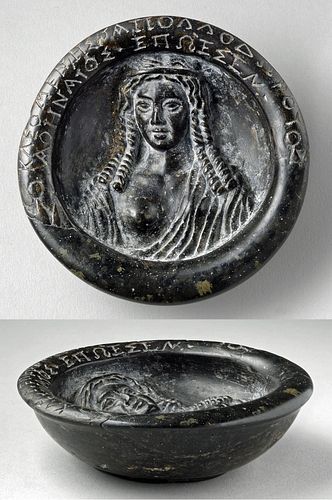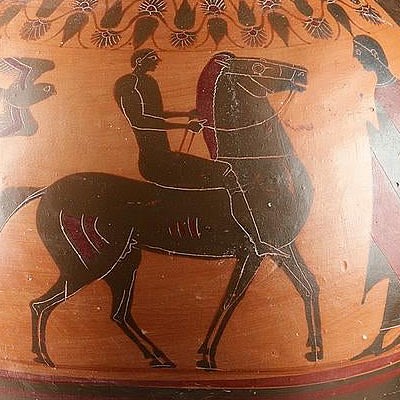Greek Hellenistic Steatite Bowl Aphrodite / Inscription
Lot 27
About Seller
Artemis Fine Arts
686 S Taylor Ave, Ste 106
Louisville, CO 80027
United States
Selling antiquities, ancient and ethnographic art online since 1993, Artemis Gallery specializes in Classical Antiquities (Egyptian, Greek, Roman, Near Eastern), Asian, Pre-Columbian, African / Tribal / Oceanographic art. Our extensive inventory includes pottery, stone, metal, wood, glass and textil...Read more
Categories
Estimate:
$12,000 - $15,000
Absentee vs Live bid
Two ways to bid:
- Leave a max absentee bid and the platform will bid on your behalf up to your maximum bid during the live auction.
- Bid live during the auction and your bids will be submitted real-time to the auctioneer.
Bid Increments
| Price | Bid Increment |
|---|---|
| $0 | $25 |
| $300 | $50 |
| $1,000 | $100 |
| $2,000 | $250 |
| $5,000 | $500 |
| $10,000 | $1,000 |
| $20,000 | $2,500 |
| $50,000 | $5,000 |
| $100,000 | $10,000 |
| $200,000 | $20,000 |
About Auction
By Artemis Fine Arts
Jun 4, 2020
Set Reminder
2020-06-04 10:00:00
2020-06-04 10:00:00
America/New_York
Bidsquare
Bidsquare : Exceptional Antiquities, Asian, Ethnographic
https://www.bidsquare.com/auctions/artemis-gallery/exceptional-antiquities-asian-ethnographic-5185
An important one-day auction featuring museum-worthy examples of Egyptian, Greek, Roman, Etruscan, Near Eastern, Far East / Asian, Pre-Columbian, African / Tribal, Oceanic, Native American, Spanish Colonial, Russian, Fossils, Ancient Jewelry, Fine Art, so much more! Artemis Fine Arts info@artemisfinearts.com
An important one-day auction featuring museum-worthy examples of Egyptian, Greek, Roman, Etruscan, Near Eastern, Far East / Asian, Pre-Columbian, African / Tribal, Oceanic, Native American, Spanish Colonial, Russian, Fossils, Ancient Jewelry, Fine Art, so much more! Artemis Fine Arts info@artemisfinearts.com
- Lot Description
Ancient Greece, Late Hellenistic, ca. 1st century BCE. Finely carved from black steatite, a striking bowl with a bust of a goddess delineated in relief on the tondo and a Greek inscription on the rim above the image. Finely delineated folds of drapery cover most but reveal her right breast and neck. Her youthful face presents large almond-shaped eyes, an aquiline nose, and full parted lips - and this lovely visage is crowned by a centrally parted coiffure adorned by a diadem, with two rows of long banana curls framing her face and falling to her shoulders. This hairstyle is characteristic of representations of Egyptian goddesses such as Isis and Hathor as well as the Ptolemaic queens, and the uncovered breast is characteristic of representations of Aphrodite. All suggests that the image likely represents the syncretic goddess Isis-Aphrodite who arose in Alexandria during the 3rd century BCE. Prior to this, Isis was associated with Hathor, goddess of love and marriage, in a sense the Egyptian equivalent to the Greek Aphrodite. Size: 3.15" in diameter (8 cm)
Adorning the lower rim of the bowl are traces of decoration, perhaps pointed flower petals or leaves from a floral swag, and the section of the rim above the goddess bears a Greek inscription. Inscribed in two lines of text, the words of the first line are separated by an incised circular motif and flanked at either end by two additional incised circles. Furthermore, a punch mark separates the words in the second line, and also appears at the end of the line. The inscription translates as follows: "Kleomenes (son) of Apollodoros the Athenian made (it)." Note that many of the letters have serifs. This, along with the fact that the alpha has a broken crossbar, is consistent with the late Hellenistic or early Roman period. Kleomenes refers to the Hellenistic sculptor, who was also the son of the famous Athenian sculptor Apollodoros. The inscription "Kleomenes, son of Apollodoros the Athenian," also appears on the sculpture of the Medici Venus - this said, that inscription is believed to be a later transcription of the ancient signature. In addition, one "Kleomenes Athenaios" signed a sculpture of Aphrodite located in Piacenza as well as an altar in Florence (Uffizi, inv. 612). Furthermore, Pliny the Elder (Natural History 36.33) states that the sculptor Kleomenes may have created a sculpture of the Thespiades - Thespius' fifty daughters with whom Heracles sired fifty sons in a single night. The inscription on this bowl probably does not suggest that the bowl itself was created by Keomenes. Instead, it more likely refers to a sculpture of the image depicted beneath the inscription that was made by Kleomenes. It is also possible that the bowl itself is a votive offering to a sanctuary. Finally this signature also may have served as advertising for the artist's sculpture and his workshop.
Scholars have noted that the design of carved stone medallions was actually inspired by impressive luxury arts in toreutics such as silver bowls and gold roundels that featured medallions with high relief busts. The styling of this bowl - as a carved medallion with a high relief bust - is also similar to Hellenistic-Roman dishes with medallions representing busts or figural scenes carved in dark stone like schist or steatite. These have been found in Egypt (designated as Alexandrian) as well as Gandhara. This blending of images of Egyptian or Greek gods and heroes adorning Ghandaran stone dishes suggests a rich transcultural exchange between the ancient cultures of the West and Asia.
This piece is accompanied by an Art Loss Register Certificate.
Provenance: private New York, USA collection; ex-Bonham’s, London, 10 June 1997; accompanied by Art Loss Register Certificate.
All items legal to buy/sell under U.S. Statute covering cultural patrimony Code 2600, CHAPTER 14, and are guaranteed to be as described or your money back.
A Certificate of Authenticity will accompany all winning bids.
We ship worldwide and handle all shipping in-house for your convenience.
#155923Professionally reassembled from large fragments. The lower part of the rim is restored. Normal surface wear with a few chips and scratches as shown.Condition
- Shipping Info
-
All shipping is handled in-house for your convenience. Your invoice from Artemis Gallery will include shipping calculation instructions. If in doubt, please inquire BEFORE bidding for estimated shipping costs for individual items.
-
- Buyer's Premium



 EUR
EUR CAD
CAD AUD
AUD GBP
GBP MXN
MXN HKD
HKD CNY
CNY MYR
MYR SEK
SEK SGD
SGD CHF
CHF THB
THB
















